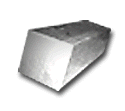Making a Cruciform Mandrel
Background
THIS IS A RAW PAGE AND DOESN"T REFLECT
CRUCIFORM WORK YET.
For my Experimental Hybrid Rocket Motor
work, and my HyperTEK Experimental in particular, I was having trouble
casting the grains because the 1.5" SCH 40 PVC pipe I used as a
insulator / fuel / casting tube when combined with a 1" coring
mandrel, only leaves 1/4" web for casting. For any casting formula that
isn't runny this isn't much thickness and contributes to a messy cast
and also the possibility of air bubbles & voids.
So for these reasons, not for solids loadings, I started thinking about
making a finocyl mandrel. The design would allow much more clearance
for pouring casting composition into the base.
For you solids guys, this is also applicable, just note that I'm coming
at this from a different angle. Note also that
Burn Sim will now
compute for finocyl cores - but I don't know yet if it'll handle the
geometries that I am coming up with. Richard Nakka also has a
finocyl
calculator spreadsheet that I also haven't tried with my geometry.
Requirements
Always state your requirements before
you start - to ensure that you end up at or close to your goals.
My requirements are
- (a) Approximate the inital
surface area of a 1" core of a 54mm HyperTEK fuel grain.
- (b) Retain clearance for the GOX fill stem tube. This tube is
3/8" OD, and I'd like to retain 1/2" diameter for clearance
Note that the core cross sectional
areas of the circular and our pseudo finocyl equivalent will not be the same even if we
succeed in computing a geometry that has the same linear surface area. This will affect the operating pressure
of the motor.
Tact and Available Components
I don't have a mill so need to be able
to do this with available tools - such as a table saw, router, or
router table. My tact is to use hexagonal bar stock
such
as this from McMaster.com or
this
from OnlineMetals.com along with a carbide cabinet pilot bit to add
the grooves to make it a finocyl.
The stock sizes we'll consider are 1", 7/8", and 3/4" between the flats.
The carbide cabinet pilot bit is a V bit with a 90 degree included
angle. Note this won't provide a perfect geometry as the hexagon's 6
triangles have a 60 degree included angle so we may consider another
bit if we can find a suitable one.
We will simply set the bit in a router table, adjust the guide for a
center across a flat, adjust the depth, and make 6 grooves.
Formulas
I worked out the formulas myself, but
if you want to see the derivation, I found a like for you that is
better than any of my notes
"The Area Of
A Hexagon"
We are starting with a hexagon, and the vendors specify the dimension
as "A" above - between the flats. We will be cutting equilateral
triangular grooves on each face.
Circumference of a circle = PI * D = 3.142
Circumference of a hexagon (1/2) A = SQRT(3) / 2 * L, so L= 1 / SQRT(3)
* A, so Circumference = 6 / SQRT(3) * A = 3.464 * A
Note that we don't actually want that above formula, as we want the
same intial surface area
which means we want the circumference
of the hexagon to match the circumference
of the 1" circular core.
Computations
Let's look at some basic circumference
computations
Circumference
|
Description
|
3.464
|
1" Hexagon
|
3.142
|
1" Circle
|
3.031
|
7/8" Hexagon
|
2.598
|
3/4" Hexagon
|
2.165
|
5/8" Hexagon
|
If we are using a 45 / 90 router bit,
then we're cutting equilateral triangle grooves, so for each Groove
Width Gw we cut away, we add twice that. So, in effect, for a cut of
Gw, we add 2 * G2 to the new circumference.
For the 3/4" Hexagon, we need 3.142 - 2.598 = .544" additional
circumference, divided by 6 grooves, yields 0.090666 per groove, or a
Groove Width Gw of 0.0453
For the 5/8" Hexagon, we need 3.142 - 2.165 = .977" additional
circumference, divided by 6 grooves, yields 0.163 per groove, or a
Groove Width Gw of 0.0815"
Checking against Requirements
The 3/4" stock. The groove, is tiny at
a hair under
3/64, may be difficult to manageably and accurately cut. It will give
us less
overall casting room than the 5/8" stock, and with respect to the GOX
tube clearance, we have 0.75 - 0.091 = 0.659 This well over
our 1/2" core goal and wider actually than the 5/8" stock - we could
drop a bar of it right in!.
The 5/8" stock looks tight. The groove, while tiny at a hair under
3/32, is at least manageably large enough to cut. It will give us more
overall casting room than the 3/4" stock, and with respect to the GOX
tube clearance, we have 0.625 - 0.163 == 0.462. This is a hair under
our 1/2" core goal and leave 0.087 or a hair under 3/32" total .
One conclusion we might reach is that a finocyl may not be the best
candidate given the relatively large inner core we need to leave with
respect to the equivalent diameter we need to maintain.
Results as built

